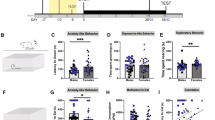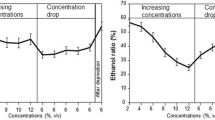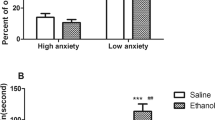Abstract
Emotional disturbances emerge following alcohol withdrawal. The anxiolytic effect of alcohol may be one important motivation for its consumption in conditions where alcohol intake is anxiety reducing. Besides, early alcohol experience will predict future alcohol-related problems at some point in their lives. Rats classified according to their anxiety-like behavior phenotype show a higher preference for alcohol. Yet, despite preclinical studies have identified the behavioral and physiological effects of alcohol withdrawal, little has been shown on relapse to alcohol after a period of abstinence following intermittent long-term alcohol consumption in low-(LA) and high-anxiety (HA) phenotype rats. This study attempts to assess the role of emotional reactivity of early-aged LA and HA rats on later alcohol preference, through an operant response procedure. For this, a sweetened liquid fading procedure associated with a long-term and intermittent voluntary alcohol drinking was used, with the animals being tested on different withdrawal periods. Alcohol withdrawal symptoms were recorded, and blood alcohol levels were assessed at two intervals to examine the influence of anxiety phenotype on blood alcohol clearance. Data from HA control and HA withdrawn rats show that emotionality selectively influences alcohol preference. Blood alcohol decay was faster in HA than in LA alcohol pretreated rats. HA rats showed an ascending curve of alcohol intake, exhibiting a high level of alcohol drinking on withdrawal and withdrawal symptoms. Moreover, HA alcohol experienced rats show a high frequency of lever-pressing response during extinction, associated with a facilitation of bar-pressing recovery trials, an indication of alcohol-seeking behavior.







Similar content being viewed by others
References
Armstrong S, Coleman G, Singer G (1980) Food and water deprivation: changes in rat feeding, drinking, activity and body weight. Neurosci Biobehav Rev 4(3):377–402
Aures D, Guth PH, Paulsen G, Grossman MI (1982) Effect of increased gastric mucosal histamine on alcohol-induced gastric damage in rats. Dig Dis Sci 27(4):347–352
Bates ME, Labouvie EW (1997) Adolescent risk factors and the prediction of persistent alcohol and drug use into adulthood. Alcohol Clin Exp Res 21(5):944–950
Bell RL, Rodd ZA, Lumeng L, Murphy JM, McBride WJ (2006) The alcohol-preferring P rat and animal models of excessive alcohol drinking. Addict Biol 11:270–288
Braun AA, Skelton MR, Vorhees CV, Williams MT (2011) Comparison of the elevated plus and elevated zero mazes in treated and untreated male Sprague–Dawley rats: effects of anxiolytic and anxiogenic agents. Pharmacol Biochem Behav 97(3):406–415
Broadwater M, Varlinskaya EI, Spear LP (2013) Effects of voluntary access to sweetened ethanol during adolescence on intake in adulthood. Alcohol Clin Exp Res 37(6):1048–1055
Brown SA, Tapert SF (2004) Adolescence and the trajectory of alcohol use: basic to clinical studies. Ann N Y Acad Sci 1021(1):234–244
Bujanda L (2000) The effects of alcohol consumption upon the gastrointestinal tract. Am J Gastroenterol 95(12):3374–3382
Candland DK, Campbell BA (1962) Development of fear in the rat as measured by behavior in the open field. J Comp Physiol Psychol 55(4):593–596
Carnicella S, Yowell QV, Ron D (2011) Regulation of operant oral ethanol self-administration: a dose-response curve study in rats. Alcohol Clin Exp Res 35(1):116–125
Carnicella S, Ron D, Barak S (2014) Intermittent ethanol access schedule in rats as a preclinical model of alcohol abuse. Alcohol 48(3):243–252
Chester JA, Barrenha GD (2007) Acoustic startle at baseline and during acute alcohol withdrawal in replicate mouse lines selectively bred for high or low alcohol preference. Alcohol Clin Exp Res 31:1633–1644
Conger JJ (1956) Alcoholism: theory, problem and challenge. II. Reinforcement theory and the dynamics of alcoholism. Q J Stud Alcohol 17:296–305
Da Silva GE, Ramos A, Takahashi RN (2004) Comparison of voluntary ethanol intake by two pairs of rat lines used as genetic models of anxiety. Braz J Med Biol Res 37(10):1511–1517
Dess NK (1991) Ingestion and emotional health. Hum Nat Hawthorne N 2(3):235–269
Dess NK, Minor TR (1996) Taste and emotionality in rats selectively bred for high versus low saccharin intake. Anim Learn Behav 24(1):105–115
DeWit DJ, Adlaf EM, Offord DR, Ogborne AC (2000) Age at first alcohol use: a risk factor for the development of alcohol disorders. Am J Psychiatry 157(5):745–750
Dilley JE, Nicholson E, Fischer SM, Zimmer R, Froehlich JC (2018) Alcohol drinking and blood alcohol concentration revisited. Alcohol Clin Exp Res 42(2):260–269
Donjam M (1982) The principles of learning and behavior. Books/Cole, Monterey
Doremus TL, Brunell SC, Varlinskaya EI, Spear LP (2003) Anxiogenic effects during withdrawal from acute ethanol in adolescent and adult rats. Pharmacol Biochem Behav 75(2):411–418
Doremus-Fitzwater TL, Varlinskaya EI, Spear LP (2009) Effects of pretest manipulation on elevated plus-maze behavior in adolescent and adult male and female Sprague–Dawley rats. Pharmacol Biochem Behav 92(3):413–423
Dyer ML, Easey KE, Heron J, Hickman M, Munafò MR (2019) Associations of child and adolescent anxiety with later alcohol use and disorders: a systematic review and meta-analysis of prospective cohort studies. Addict Abingdon Engl 114(6):968–982
Dyr W, Kostowski W (2000) Animal model of ethanol abuse: rats selectively bred for high and low voluntary alcohol intake. Acta Pol Pharm 57(Suppl):90–92
Easey KE, Dyer ML, Timpson NJ, Munafò MR (2019) Prenatal alcohol exposure and offspring mental health: a systematic review. Drug Alcohol Depend 1(197):344–353
Ezequiel Leite L, Nobre MJ (2012) The negative effects of alcohol hangover on high-anxiety phenotype rats are influenced by the glutamate receptors of the dorsal midbrain. Neuroscience 213:93–105
Fox HC, Bergquist KL, Hong KI, Sinha R (2007) Stress-induced and alcohol cue-induced craving in recently abstinent alcohol-dependent individuals. Alcohol Clin Exp Res 31:395–403
Grant BF, Dawson DA (1997) Age at onset of alcohol use and its association with DSM-IV alcohol abuse and dependence: results from the National Longitudinal Alcohol Epidemiologic Survey. J Subst Abuse 9:103–110
Hayashi T, Tadokoro S (1985) Learning retardation and enhanced ethanol preference produced by postnatal pretreatments with ethanol in adult rats. Jpn J Pharmacol 37(3):269–276
Hefner K, Holmes A (2007) An investigation of the behavioral actions of ethanol across adolescence in mice. Psychopharmacology 191(2):311–322
Heilig M, Egli M, Crabbe JC, Becker HC (2010) Acute withdrawal, protracted abstinence and negative affect in alcoholism: are they linked? Addict Biol 15:169–184
Henniger MS, Spanagel R, Wigger A, Landgraf R, Holter SM (2002) Alcohol self-administration in two rat lines selectively bred for extremes in anxiety-related behavior. Neuropsychopharmacology 26:729–736
Hingson RW, Zha W (2009) Age of drinking onset, alcohol use disorders, frequent heavy drinking, and unintentionally injuring oneself and others after drinking. Pediatrics 123(6):1477–1484
Holloway FA, Bird DC, Devenport JA (1984) Periodic availability: factors affecting alcohol selection in rats. Alcohol 1:19–25
Holt S (1981) Observations on the relation between alcohol absorption and the rate of gastric emptying. Can Med Assoc J 124(3):267–277, 297
Hunter BE, Riley JN, Walker DW (1975) Ethanol dependence in the rat: a parametric analysis. Pharmacol Biochem Behav 3:619–629
Hwang BH, Stewart R, Zhang JK, Lumeng L, Li TK (2004) Corticotropin-releasing factor gene expression is down-regulated in the central nucleus of the amygdala of alcohol-preferring rats which exhibit high anxiety: a comparison between rat lines selectively bred for high and low alcohol preference. Brain Res 1026:143–150
Jadhav KS, Magistretti PJ, Halfon O, Augsburger M, Boutrel B (2017) A preclinical model for identifying rats at risk of alcohol use disorder. Sci Rep 7(1):9454
Jesse S, Bråthen G, Ferrara M, Keindl M, Ben-Menachem E, Tanasescu R, Brodtkorb E, Hillbom M, Leone MA, Ludolph AC (2017) Alcohol withdrawal syndrome: mechanisms, manifestations, and management. Acta Neurol Scand 135(1):4–16
Jimenez-Gomez C, Shahan TA (2007) Resistance to change of alcohol self-administration: effects of alcohol-delivery rate on disruption by extinction and naltrexone. Behav Pharmacol 18(2):161–169
Katner SN, Magalong JG, Weiss F (1999) Reinstatement of alcohol-seeking behavior by drug-associated discriminative stimuli after prolonged extinction in the rat. Neuropsychopharmacology 20:471–479
Kayir H, Uzbay T (2008) Effects of clozapine on ethanol withdrawal syndrome in rats. Alcohol Alcohol 43:619–625
Kendler KS, Gardner C, Dick DM (2011) Predicting alcohol consumption in adolescence from alcohol-specific and general externalizing genetic risk factors, key environmental exposures and their interaction. Psychol Med 41(7):1507–1516
Kessler RC, Crum RM, Warner LA, Nelson CB, Schulenberg J, Anthony JC (1997) Lifetime co-occurrence of DSM-III-R alcohol abuse and dependence with other psychiatric disorders in the National Comorbidity Survey. Arch Gen Psychiatry 54:313–321
Koob GF (2013) Theoretical frameworks and mechanistic aspects of alcohol addiction: alcohol addiction as a reward deficit disorder. Curr Top Behav Neurosci 13:3–30
Kulkarni SK, Singh K, Bishnoi M (2007) Elevated zero maze: a paradigm to evaluate antianxiety effects of drugs. Methods Find Exp Clin Pharmacol 29:343–348
Kushner MG, Sher KJ, Beitman BD (1990) The relation between alcohol problems and the anxiety disorders. Am J Psychiatry 147:685–695
Langen B, Fink H (2004) Anxiety as a predictor of alcohol preference in rats? Prog Neuropsychopharmacol Biol Psychiatry 28:961–968
Le AD, Kiianmaa K, Cunningham CL, Engel JA, Ericson M, Soderpalm B, Koob GF, Roberts AJ, Weiss F, Hyytia P, Janhunen S, Mikkola J et al (2001) Neurobiological processes in alcohol addiction. Alcohol Clin Exp Res 25:144S–151S
Lieber CS, DeCarli LM, Sorrell MF (1989) Experimental methods of ethanol administration. Hepatology 10:501–510
Lin Y, Weidler DJ, Garg DC, Wagner JG (1976) Effects of solid food on blood levels of alcohol in man. Res Commun Chem Pathol Pharmacol 13(4):713–722
Litvin Y, Pentkowski NS, Pobbe RL, Blanchard DC, Blanchard RJ (2008) Chapter 2.5 Unconditioned models of fear and anxiety. In: Blanchard RJ, Blanchard DC, Griebel G, Nutt D (eds) Handbook of behavioral neuroscience. Elsevier, Amsterdam, pp 81–99
Macey DJ, Schulteis G, Heinrichs SC, Koob GF (1996) Time-dependent quantifiable withdrawal from ethanol in the rat: effect of method of dependence induction. Alcohol 13:163–170
Maier DM, Pohorecky LA (1989) The effect of repeated withdrawal episodes on subsequent withdrawal severity in ethanol-treated rats. Drug Alcohol Depend 23(2):103–110
Marshall EJ (2014) Adolescent alcohol use: risks and consequences. Alcohol Alcohol 49(2):160–164
Matson L, Liangpunsakul S, Crabb D, Buckingham A, Ross RA, Halcomb M, Grahame N (2013) Chronic free-choice drinking in crossed high alcohol preferring mice leads to sustained blood ethanol levels and metabolic tolerance without evidence of liver damage. Alcohol Clin Exp Res 37:194–201
Mayfield RD, Harris RA, Schuckit MA (2008) Genetic factors influencing alcohol dependence. Br J Pharmacol 154(2):275–287
McCambridge J, McAlaney J, Rowe R (2011) Adult consequences of late adolescent alcohol consumption: a systematic review of cohort studies. PLoS Med 8(2):e1000413
Melendez RI (2011) Intermittent (every-other-day) drinking induces rapid escalation of ethanol intake and preference in adolescent and adult C57BL/6J mice. Alcohol Clin Exp Res 35(4):652–658
Möller C, Wiklund L, Sommer W, Thorsell A, Heilig M (1997) Decreased experimental anxiety and voluntary ethanol consumption in rats following central but not basolateral amygdala lesions. Brain Res 760(1–2):94–101
Nobre MJ (2016) Environmental enrichment may protect against neural and behavioural damage caused by withdrawal from chronic alcohol intake. Int J Dev Neurosci 55:15–27
Overstreet DH, Halikas JA, Seredenin SB, Kampov-Polevoy AB, Viglinskaya IV, Kashevskaya O, Badishtov BA, Knapp DJ, Mormede P, Kiianmaa K, Li TK, Rezvani AH (1997) Behavioral similarities and differences among alcohol-preferring and -non preferring rats: confirmation by factor analysis and extension to additional groups. Alcohol Clin Exp Res 21:840–848
Pikaar NA, Wedel M, Hermus RJ (1988) Influence of several factors on blood alcohol concentrations after drinking alcohol. Alcohol Alcohol Oxf Oxfs 23(4):289–297
Saglam E, Kayir H, Celik T, Uzbay T (2006) Effects of escitalopram on ethanol withdrawal syndrome in rats. Prog Neuropsychopharmacol Biol Psychiatry 30:1027–1032
Schramm-Sapyta NL, Kingsley MA, Rezvani AH, Propst K, Swartzwelder HS, Kuhn CM (2008) Early ethanol consumption predicts relapse-like behavior in adolescent male rats. Alcohol Clin Exp Res 32:754–762
Schulteis G, Liu J (2006) Brain reward deficits accompany withdrawal (hangover) from acute ethanol in rats. Alcohol 39:21–28
Schulteis G, Markou A, Cole M, Koob GF (1995) Decreased brain reward produced by ethanol withdrawal. Proc Natl Acad Sci 92:5880–5884
Shahan TA, Burke KA (2004) Ethanol-maintained responding of rats is more resistant to change in a context with added non-drug reinforcement. Behav Pharmacol 15(4):279–285
Shepherd JK, Grewal SS, Fletcher A, Bill DJ, Dourish CT (1994) Behavioural and pharmacological characterisation of the elevated “zero-maze” as an animal model of anxiety. Psychopharmacol Berl 116:56–64
Siegmund S, Vengeliene V, Singer MV, Spanagel R (2005) Influence of age at drinking onset on long-term ethanol self-administration with deprivation and stress phases. Alcohol Clin Exp Res 29(7):1139–1145
Simms JA, Steensland P, Medina B, Abernathy KE, Chandler LJ, Wise R, Bartlett SE (2008) Intermittent access to 20% ethanol induces high ethanol consumption in Long-Evans and Wistar rats. Alcohol Clin Exp Res 32:1816–1823
Sinha R, Li CS (2007) Imaging stress- and cue-induced drug and alcohol craving: association with relapse and clinical implications. Drug Alcohol Rev 26:25–31
Spanagel R, Montkowski A, Allingham K, Stohr T, Shoaib M, Holsboer F, Landgraf R (1995) Anxiety: a potential predictor of vulnerability to the initiation of ethanol self-administration in rats. Psychopharmacol Berl 122:369–373
Stewart RB, Gatto GJ, Lumeng L, Li TK, Murphy JM (1993) Comparison of alcohol-preferring (P) and nonpreferring (NP) rats on tests of anxiety and for the anxiolytic effects of ethanol. Alcohol 10:1–10
Tangerman A (1997) Highly sensitive gas chromatographic analysis of ethanol in whole blood, serum, urine, and fecal supernatants by the direct injection method. Clin Chem 43:1003–1009
Tolliver GA, Sadeghi KG, Samson HH (1988) Ethanol preference following the sucrose-fading initiation procedure. Alcohol 5(1):9–13
Welch KA, Carson A, Lawrie SM (2013) Brain structure in adolescents and young adults with alcohol problems: systematic review of imaging studies. Alcohol Alcohol 48(4):433–444
Wilkinson PK, Wagner JG, Sedman AJ (1975) Sensitive head-space gas chromatographic method for the determination of ethanol utilizing capillary blood samples. Anal Chem 47:1506–1510
Willinger U, Lenzinger E, Hornik K, Fischer G, Schonbeck G, Aschauer HN, Meszaros K (2002) Anxiety as a predictor of relapse in detoxified alcohol-dependent patients. Alcohol Alcohol 37:609–612
Wise R (1973) Voluntary ethanol intake in rats following exposure to ethanol on various schedules. Psychopharmacologia 29:203–210
Zhang Z, Morse AC, Koob GF, Schulteis G (2007) Dose- and time-dependent expression of anxiety-like behavior in the elevated plus-maze during withdrawal from acute and repeated intermittent ethanol intoxication in rats. Alcohol Clin Exp Res 31:1811–1819
Acknowledgements
This study was supported by FAPESP (Proc. No. 2010/15157-4). M.J. Nobre is the recipient of a Productivity Research Grant from CNPq (303144/2015-7). R.F. Sgobbi holds a post-doctoral fellowship from FAPESP (2014/09685-9). We declare that the sponsors have not been involved in or influenced the design, collection, analysis or interpretation of study data, nor the writing of the report or the decision to submit it for publication.
Author information
Authors and Affiliations
Corresponding author
Additional information
Communicated by Thomas Deller.
Publisher's Note
Springer Nature remains neutral with regard to jurisdictional claims in published maps and institutional affiliations.
Electronic supplementary material
Below is the link to the electronic supplementary material.
221_2020_5932_MOESM1_ESM.tif
Supplemental data. The experimental procedure adopted to induce alcohol preference. Overall, treatments lasted for sixty-eight days (free-drinking), followed by one day of alcohol deprivation, one session of lever-pressing response (operant drinking) and operant response extinction, one lever-pressing recovery session, a second operant drinking/extinction session, and a second recovery session of lever-pressing, spaced by twenty-four hours among them. Saccharin was removed from the fluid at the end of the 6th week of treatments (TIF 192 kb)
Rights and permissions
About this article
Cite this article
Sgobbi, R.F., Nobre, M.J. Differential effects of early exposure to alcohol on alcohol preference and blood alcohol levels in low- and high-anxious rats. Exp Brain Res 238, 2753–2768 (2020). https://doi.org/10.1007/s00221-020-05932-6
Received:
Accepted:
Published:
Issue Date:
DOI: https://doi.org/10.1007/s00221-020-05932-6




